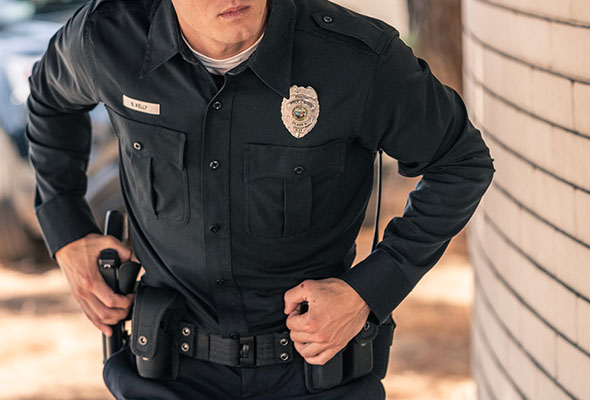How to Wear Different Holsters
A holster is the safest way to carry a firearm, but knowing exactly how to wear it isn't always intuitive, even if you’re a seasoned concealed carry permit-holder. Every holster is different – and so is every body. What works for your brother- or sister-in-arms might not work for you.
Take steps to ensure your safety and maintain easy access to your firearm when you're downrange, on patrol or carrying in public. Read our tips on how to wear standard and concealed carry holsters the right way.

How to Wear a Shoulder Holster
Shoulder holsters are designed for cross-body draws, and they’re typically the most comfortable types of holsters you’ll find. Follow these steps to put on a shoulder holster properly:
- Slip the empty holster rig over your shoulders, like you would put on a backpack.
- Adjust the rig so the straps in the back cross right below the base of your neck. Don’t let the straps twist.
- Tighten the straps so they’re tight against your body.
- Move at the waist by twisting, bending down and reaching up. If your holster moves a lot, tighten your straps. (A little movement is good, but not a lot.)
- Slide the gun holster, if yours is mobile, to the most comfortable draw position. Put it where your hand naturally goes when you reach for your firearm; for most people, this is the mid-rib or lower armpit area.
- Adjust the holster’s angle based on what feels natural to you.
- Holster your firearm only after the rig is comfortable and snug against your body. Practice drawing so you can readjust the holster’s placement and angle if necessary.
How to Wear a Thigh Holster
A thigh or drop-leg holster typically attaches to your belt and runs down just past your groin. For some people, it feels a lot more natural to draw from there than from the hip. Generally, you want the butt of your firearm to jut out from the holster just below your hip and above where your hand hangs naturally.
Here’s how to put on a drop-leg holster:
- Strap the holster to your thigh and pull the straps tight enough to anchor it. It should sit in place before you even attach the strap to your belt.
- Fasten the holster to your belt.
- Holster your firearm after you have a proper fit.
How to Wear an Ankle Holster
Wearing an ankle holster is ideal if you’ll draw from any position other than standing. But if you’re tall, drawing from this type of holster can be awkward. The same is true if you have thin ankles.
If you like this style, the first step for wearing an ankle holster is choosing which leg to attach it to. This choice depends on whether you want your firearm on the outside or the inside of your leg. Right-handed shooters typically wear an ankle holster inside the left leg or outside the right leg, while southpaws wear it inside the right leg or outside the left.
Safety Tip: If you wear your ankle holster on the outside, you’ll probably bump it into things frequently until you get used to it.
How to Wear a Back Holster or Waist Holster
Drawing from the small of your back can be tricky because it requires a longer arm motion – it can also be uncomfortable if you spend a lot of time seated. If you fall with a gun in the small of your back, where it sits right over your spine and pelvis, the injury from the butt can really knock you out of commission.
An inside-the-waistband (IWB) holster is one of the most convenient ways to carry on your backside. An IWB holster goes around your waist, between your pants and your body. Place the holster toward the back of your body on your dominant side, and adjust the angle so you can reach it naturally. Point the grip of your firearm toward your dominant side.
An outside-the-waistband holster is also worn at the waist, usually at the hip. Normally, hip holsters attach to your belt by a loop or with a clip.
Holstering your gun is much safer than tucking it away or zipping it into a pocket. Because holsters give you easier and more reliable access to your firearm, it pays to know how to wear a holster properly. Choosing a holster should be based on how you already draw and what your body does naturally. Combine the guidance above with your personal needs and preferences to find the perfect fit.